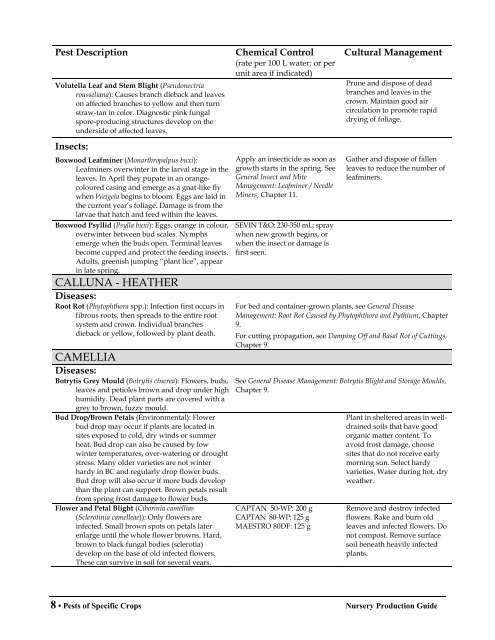You also want an ePaper? Increase the reach of your titles
YUMPU automatically turns print PDFs into web optimized ePapers that Google loves.
Pest Description<br />
Volutella Leaf and Stem Blight (Pseudonectria<br />
rousseliana): Causes branch dieback and leaves<br />
on affected branches to yellow and then turn<br />
straw-tan in color. Diagnostic pink fungal<br />
spore-producing structures develop on the<br />
underside <strong>of</strong> affected leaves.<br />
Insects:<br />
Boxwood Leafminer (Monarthropalpus buxi):<br />
Leafminers overwinter in the larval stage in the<br />
leaves. In April they pupate in an orangecoloured<br />
casing and emerge as a gnat-like fly<br />
when Weigela begins to bloom. Eggs are laid in<br />
the current year’s foliage. Damage is from the<br />
larvae that hatch and feed within the leaves.<br />
Boxwood Psyllid (Psylla buxi): Eggs, orange in colour,<br />
overwinter between bud scales. Nymphs<br />
emerge when the buds open. Terminal leaves<br />
become cupped and protect the feeding insects.<br />
Adults, greenish jumping “plant lice”, appear<br />
in late spring.<br />
CALLUNA - HEATHER<br />
Diseases:<br />
Root Rot (Phytophthora spp.): Infection first occurs in<br />
fibrous roots, then spreads to the entire root<br />
system and crown. Individual branches<br />
dieback or yellow, followed by plant death.<br />
CAMELLIA<br />
Diseases:<br />
Botrytis Grey Mould (Botrytis cinerea): Flowers, buds,<br />
leaves and petioles brown and drop under high<br />
humidity. Dead plant parts are covered with a<br />
grey to brown, fuzzy mould.<br />
Bud Drop/Brown Petals (Environmental): Flower<br />
bud drop may occur if plants are located in<br />
sites exposed to cold, dry winds or summer<br />
heat. Bud drop can also be caused by low<br />
winter temperatures, over-watering or drought<br />
stress. Many older varieties are not winter<br />
hardy in BC and regularly drop flower buds.<br />
Bud drop will also occur if more buds develop<br />
than the plant can support. Brown petals result<br />
from spring frost damage to flower buds.<br />
Flower and Petal Blight (Ciborinia camellias<br />
(Sclerotinia camelleae)): Only flowers are<br />
infected. Small brown spots on petals later<br />
enlarge until the whole flower browns. Hard,<br />
brown to black fungal bodies (sclerotia)<br />
develop on the base <strong>of</strong> old infected flowers.<br />
These can survive in soil for several years.<br />
Chemical Control<br />
(rate per 100 L water; or per<br />
unit area if indicated)<br />
Apply an insecticide as soon as<br />
growth starts in the spring. See<br />
General Insect and Mite<br />
Management: Leafminer / Needle<br />
Miners, Chapter 11.<br />
SEVIN T&O: 230-350 mL; spray<br />
when new growth begins, or<br />
when the insect or damage is<br />
first seen.<br />
Cultural Management<br />
Prune and dispose <strong>of</strong> dead<br />
branches and leaves in the<br />
crown. Maintain good air<br />
circulation to promote rapid<br />
drying <strong>of</strong> foliage.<br />
Gather and dispose <strong>of</strong> fallen<br />
leaves to reduce the number <strong>of</strong><br />
leafminers.<br />
For bed and container-grown plants, see General Disease<br />
Management: Root Rot Caused by Phytophthora and Pythium, Chapter<br />
9.<br />
For cutting propagation, see Damping Off and Basal Rot <strong>of</strong> Cuttings,<br />
Chapter 9.<br />
See General Disease Management: Botrytis Blight and Storage Moulds,<br />
Chapter 9.<br />
CAPTAN 50-WP: 200 g<br />
CAPTAN 80-WP: 125 g<br />
MAESTRO 80DF: 125 g<br />
Plant in sheltered areas in welldrained<br />
soils that have good<br />
organic matter content. To<br />
avoid frost damage, choose<br />
sites that do not receive early<br />
morning sun. Select hardy<br />
varieties. Water during hot, dry<br />
weather.<br />
Remove and destroy infected<br />
flowers. Rake and burn old<br />
leaves and infected flowers. Do<br />
not compost. Remove surface<br />
soil beneath heavily infected<br />
plants.<br />
8 • <strong>Pests</strong> <strong>of</strong> <strong>Specific</strong> <strong>Crops</strong> Nursery Production Guide
















